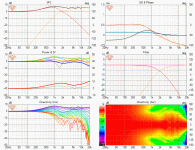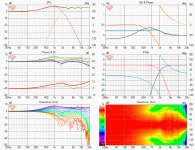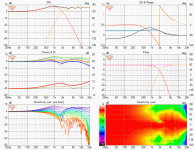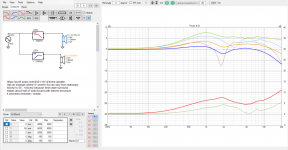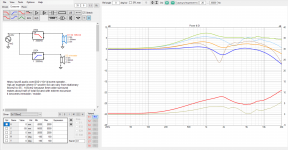Rating a speaker's faithfulness in reproducing music mainly by means of THD is highly suspect. In my findings, audibility of THD is about proportionality in magnitude of individual odd vs even HD components along with which area of FR this distortion occurs.
The type of music you listen to and prefer also will be a factor. My go to tests are piano and vocals. Piano music is extremely complex and difficult to reproduce correctly along with mimicking the acoustic space it was recorded in. The micing technique used to record the piano is a critical factor in its validity as a source in evaluating a speaker system's reproduction accuracy. The typical "head in the piano" sound that many multi track recordings employ sounds artificial and exaggerated in sound stage. I prefer a piano be miced by some means of mid-far field method which "hears" the piano in a similar way you the listener would perceive it being in the room. Vocals should be miced in stereo to achieve a sense of unexagerated spaciousness, so you can hear the relative physical location of the vocalist. Even better would be a mid-field stereo recording of solo and multiple vocalists that includes the rooms natural acoustics.
IMD distortion is highly audible in alot of instances, especially in larger 2 way systems with relatively high crossover points. This also should include fullrange drivers as well. The type of motor system used plays a huge factor here ie under vs overhung VC and the amount of over- or under-hang. For me, a lack of inductance control isn't a deal breaker, but in most cases it helps in reducing Le (VC inductance) swing and modulation, which also can be highly audible, even at lower levels.
Thermal compression can be very audible if you like to listen loud to music with sustained loud passages. I love big band music and find that many (if not most) conventional speakers fall short in the sustained dynamic capability needed to faithfully play back this type of music. High efficiency LF drivers with large VCs along with HF compression drivers are a must here to get the dynamics right. The exception here may be a higher-end, low distortion AMT HF driver, but to my ears many AMTs fall short in this category, especially when pushed hard crossed lower in the 2 kHz range.
The type of music you listen to and prefer also will be a factor. My go to tests are piano and vocals. Piano music is extremely complex and difficult to reproduce correctly along with mimicking the acoustic space it was recorded in. The micing technique used to record the piano is a critical factor in its validity as a source in evaluating a speaker system's reproduction accuracy. The typical "head in the piano" sound that many multi track recordings employ sounds artificial and exaggerated in sound stage. I prefer a piano be miced by some means of mid-far field method which "hears" the piano in a similar way you the listener would perceive it being in the room. Vocals should be miced in stereo to achieve a sense of unexagerated spaciousness, so you can hear the relative physical location of the vocalist. Even better would be a mid-field stereo recording of solo and multiple vocalists that includes the rooms natural acoustics.
IMD distortion is highly audible in alot of instances, especially in larger 2 way systems with relatively high crossover points. This also should include fullrange drivers as well. The type of motor system used plays a huge factor here ie under vs overhung VC and the amount of over- or under-hang. For me, a lack of inductance control isn't a deal breaker, but in most cases it helps in reducing Le (VC inductance) swing and modulation, which also can be highly audible, even at lower levels.
Thermal compression can be very audible if you like to listen loud to music with sustained loud passages. I love big band music and find that many (if not most) conventional speakers fall short in the sustained dynamic capability needed to faithfully play back this type of music. High efficiency LF drivers with large VCs along with HF compression drivers are a must here to get the dynamics right. The exception here may be a higher-end, low distortion AMT HF driver, but to my ears many AMTs fall short in this category, especially when pushed hard crossed lower in the 2 kHz range.
Note: that my intended comparison was the listener identifying/"assessing" 2nd order with headphones vs. 2nd order speakers (and at least 8 feet from the loudspeaker in a typical listening room). Even then orders of magnitude is BS, but it might come close to an order of magnitude.More difficult, yes, but not "orders of magnitude".
Edited for stupidity.
Last edited:
Alex Voishvilo did a similar study at JBL and concluded the same things I did.We need more research to confirm or refute or refine your findings.
I know of no scientific studies that refute it
Just like climate change, it's best not to discount the experts in the field.Let’s not let it get lost in the annals of AES journals.
Last edited:
You lost me.Now we might get closer to orders of magnitude if it's only 2nd order pure tone for the headphone (as with most of the last-century headphone testing papers), vs. 2nd order addition with a music signal reproduced with speakers as previously noted.
I lost me as well.. that sentenceYou lost me.
I read it after posting and was like "wtf? ..that doesn't make any sense at all!"
Complex music signals tend to mask a lot of things that are very evident with certain other signal types. Speech, of someone familiar, is very telling.
At any rate I am not clear on what your implying about using headphones versus speakers. We weren't testing either, just controlled nonlinear modifications of a certain musical signal. One could do the same thing across many different musical signals, but I suspect that the "errors" would be more masked by "complex musical" signals, leading to a lessor resolution of the test.
We used Tracy Chapman because of a comment by Sean Olive. He said that Tracy Chapman showed the highest differentiation of any of the musical sources that they tested. It's very telling.
At any rate I am not clear on what your implying about using headphones versus speakers. We weren't testing either, just controlled nonlinear modifications of a certain musical signal. One could do the same thing across many different musical signals, but I suspect that the "errors" would be more masked by "complex musical" signals, leading to a lessor resolution of the test.
We used Tracy Chapman because of a comment by Sean Olive. He said that Tracy Chapman showed the highest differentiation of any of the musical sources that they tested. It's very telling.
Is the test where you were testing at like 105db with compression drivers? Do you have a link to your test?We used Tracy Chapman because of a comment by Sean Olive. He said that Tracy Chapman showed the highest differentiation of any of the musical sources that they tested. It's very telling.
Yup, that's what I was thinking - where much of the early work on non-linear distortion perception with speech isn't indicative of the result with most complex music.Complex music signals tend to mask a lot of things that are very evident with certain other signal types. Speech, of someone familiar, is very telling.
Well, you are testing a range of subjects and their ability to become aware of non-linear distortion with various music sources. That the source's spectral density is different is a factor. If the speaker is extreme near-field (headphone) vs. far-field w/ room influences are different factors. I'd even argue that the contribution of the distortion, either as part of the signal or actually part of the *loudspeaker is a factor.At any rate I am not clear on what your implying about using headphones versus speakers. We weren't testing either, just controlled nonlinear modifications of a certain musical signal.
*as with a test where you have two loudspeakers that are otherwise identical (or very nearly so) except for their non-linear distortion.
My guess is that there is greater masking with complex music vs speech, greater masking with loudspeakers in-room than headphones, and (far more of a guess) greater masking with the signal's distortion addition as opposed to the loudspeaker/drivers distortion additions.
In other words, for the most part I think much of the detection thresholds for 2nd order that utilized headphones and speech are so much lower than for loudspeakers and complex music that it isn't really comparable. (..and of course that loudspeakers and complex music are what most of us are interested in, and in this case their relation to the audible awareness of non-linear effects - in particular by those loudspeaker drivers.)
Last edited:
^
To me all this means is that simply put if you can't hear the distortion on headphones then you certainly won't hear it on complex music over loudspeakers in rooms.
Thus the regression numbers (Gm) we obtained from our data would be quite conservative for loudspeakers. A low index on Gm thus means inaudible on loudspeakers in rooms with complex music. Hence support for my conclusion that nonlinearities in loudspeakers are not significant until they are pushed beyond their design constraints. And this tends to not be a gradual thing (audibly.) As the levels go up things start to "clip" and we all know how that sounds and recognize it right away. Which is why clipping distortion always rates quite high in Gm.
To me all this means is that simply put if you can't hear the distortion on headphones then you certainly won't hear it on complex music over loudspeakers in rooms.
Thus the regression numbers (Gm) we obtained from our data would be quite conservative for loudspeakers. A low index on Gm thus means inaudible on loudspeakers in rooms with complex music. Hence support for my conclusion that nonlinearities in loudspeakers are not significant until they are pushed beyond their design constraints. And this tends to not be a gradual thing (audibly.) As the levels go up things start to "clip" and we all know how that sounds and recognize it right away. Which is why clipping distortion always rates quite high in Gm.
What Sean Olive actually said, is that THD, which is mainly dominated by H2 and H3, is was not highly correlated to listener preference. Which is what you're saying Earl, I get that.
But this is actually what he said recently (2021)
Reference:
Copyright Erin's Audio Corner
Transcript from 25mins40secs
Sean:
"Now you know at this time we didn't have very sophisticated distortion measurements so i'm not claiming that distortion is a meaningless uh predictor of sound quality i think understood largely uh i think it's it's true that distortion measurements can still need to be uh more refined in terms of being perceptually meaningful so that all this proves is that the traditional THD especially low order uh we only looked at second and third harmonics so we found they were not highly correlated at all not highly predictive but if we looked at higher harmonics we know that
as you go up to higher order harmonics that are less masked uh and they're more audible so uh so this this just shows in this case we didn't uh distortion wasn't uh perceptually a big factor in these tests and but and also our measurements were not very uh perceptually meaningful
Erin: um a question on this so when you were doing the testing what was the average i'm assuming the average spl is probably low enough for you probably not hitting distortion limits of a speaker too would
that be a factor or is that maybe not true
Sean: yeah i think that's fair assessment i mean the average level might have been around 80 dB C weighted and yeah we might have been hitting peaks of the night over 90 but you know these
distortion measurements here were measured at 90 db so there's certainly there's some evidence of high levels of harmonic distortion but these were seldom probably hit during the listening test okay
but uh you know when i wrote this paper uh i actually uh quoted as references Tool and Klippel
who said in their tests they didn't find distortion to be a significant variable or predictor of sound quality
and now that Wolfgang's selling all this distortion measurement equipment
i always like to remind him that in 1990 when he did his PhD he said distortion wasn't a factor
Erin: Yeah yeah i'll have to get him one sometime to help explain it to me a little bit more
It's disappointing to many of us that you are in retirement, thus no longer active in scientific research, and the Gedlee metric hasn't been widely adopted.
But ff there's one thing I know about research, is that research begets more research. There's always limitations in one's findings. It's not an open and shut case.
Here's his slide on distortion measurements:

Some general observations:
Sample size: 13
Range of Max H2 distortion within group: 1.61 - 45%
Range of Max H3 distortion within group: 37.86 - 561.48%(!)
This year (2022) there will a transducer release that has this frequency response, and H2 and H3. Its an a 8" transducer, and thus I've cropped the image to 3Khz.

H2:
At 20Hz is 33dB down (2.23%)
At 50hz is 49dB down (0.35%)
At 100Hz is 63dB down (0.07%)
At1000Hz is 70dB down (0.03%)
At3000Hz is 69dB down (0.04%)
Maximum H2 is 2.23%
H3:
At 20hz is 44dB down (0.63%)
At 50hz is 63dB down (0.07%)
At 100Hz >77dB down (~0.01%)
At 1000Hz is >78dB down (~0.01%)
At 3000Hz is >80dB down (<0.01%)
Maximum H3 is 0.63%
Note these maximum as all at 20Hz, due to displacement limitations.
But for the rest of the musical content range, the distortion is in the area of less than fractions of a percent.
Can I just circle back to those 13 speakers?
Range of Max H2 distortion within group: 1.61 - 45%
Range of Max H3 distortion within group: 37.86 - 561.48%(!)
Hypothesis: Distortion testing has been traditionally limited by loudspeaker drive units, or transducers. With the new generation of ultra low distortion loudspeaker drive units, new listening tests can be conducted to determine the effect of low distortion on distortion preference and overall listener preference.
Plain English: Are we sure distortion doesn't matter? Perhaps we can't sort the wheat from the chaff, because everything has been chaff? Or maybe we like chaff?
I'm designing 2 different speakers with exactly the same spinorama (or as closely as possible, within +/- 0.5-1dB), and conducting double blinded listening tests. And the listener is able to play whatever song they want, and adjust the volume up and down. Just like in real listening tests.
There's a saying in medical school and it goes something like this
"Half of what we are going to teach you is wrong, and half of it is right."
"The problem is that we don't know which is which"
The point of it is that a dedication to scientific enquiry is that it's lifelong. What we (thought) we know now, will be shown not to be correct ( slightly incorrect, or completely incorrect) in 5, 10, or 20 years time.
It was a speech to prepare us for a lifelong commitment to learning. In the modern era, there a fancy term called growth mindset.
But it’s not all that new.
It's ok to change one's mind on the matter. In fact it was Keynes (or Samuelson) and popularised by Churchill, who famously quipped:
"When the facts change, I change my mind. What do you do, madam?"
Furthermore:

"more research needs to be done on non-linear distortion and directivity"
But this is actually what he said recently (2021)
Reference:
Transcript from 25mins40secs
Sean:
"Now you know at this time we didn't have very sophisticated distortion measurements so i'm not claiming that distortion is a meaningless uh predictor of sound quality i think understood largely uh i think it's it's true that distortion measurements can still need to be uh more refined in terms of being perceptually meaningful so that all this proves is that the traditional THD especially low order uh we only looked at second and third harmonics so we found they were not highly correlated at all not highly predictive but if we looked at higher harmonics we know that
as you go up to higher order harmonics that are less masked uh and they're more audible so uh so this this just shows in this case we didn't uh distortion wasn't uh perceptually a big factor in these tests and but and also our measurements were not very uh perceptually meaningful
Erin: um a question on this so when you were doing the testing what was the average i'm assuming the average spl is probably low enough for you probably not hitting distortion limits of a speaker too would
that be a factor or is that maybe not true
Sean: yeah i think that's fair assessment i mean the average level might have been around 80 dB C weighted and yeah we might have been hitting peaks of the night over 90 but you know these
distortion measurements here were measured at 90 db so there's certainly there's some evidence of high levels of harmonic distortion but these were seldom probably hit during the listening test okay
but uh you know when i wrote this paper uh i actually uh quoted as references Tool and Klippel
who said in their tests they didn't find distortion to be a significant variable or predictor of sound quality
and now that Wolfgang's selling all this distortion measurement equipment
i always like to remind him that in 1990 when he did his PhD he said distortion wasn't a factor
Erin: Yeah yeah i'll have to get him one sometime to help explain it to me a little bit more
It's disappointing to many of us that you are in retirement, thus no longer active in scientific research, and the Gedlee metric hasn't been widely adopted.
But ff there's one thing I know about research, is that research begets more research. There's always limitations in one's findings. It's not an open and shut case.
Here's his slide on distortion measurements:
Some general observations:
Sample size: 13
Range of Max H2 distortion within group: 1.61 - 45%
Range of Max H3 distortion within group: 37.86 - 561.48%(!)
This year (2022) there will a transducer release that has this frequency response, and H2 and H3. Its an a 8" transducer, and thus I've cropped the image to 3Khz.
H2:
At 20Hz is 33dB down (2.23%)
At 50hz is 49dB down (0.35%)
At 100Hz is 63dB down (0.07%)
At1000Hz is 70dB down (0.03%)
At3000Hz is 69dB down (0.04%)
Maximum H2 is 2.23%
H3:
At 20hz is 44dB down (0.63%)
At 50hz is 63dB down (0.07%)
At 100Hz >77dB down (~0.01%)
At 1000Hz is >78dB down (~0.01%)
At 3000Hz is >80dB down (<0.01%)
Maximum H3 is 0.63%
Note these maximum as all at 20Hz, due to displacement limitations.
But for the rest of the musical content range, the distortion is in the area of less than fractions of a percent.
Can I just circle back to those 13 speakers?
Range of Max H2 distortion within group: 1.61 - 45%
Range of Max H3 distortion within group: 37.86 - 561.48%(!)
Hypothesis: Distortion testing has been traditionally limited by loudspeaker drive units, or transducers. With the new generation of ultra low distortion loudspeaker drive units, new listening tests can be conducted to determine the effect of low distortion on distortion preference and overall listener preference.
Plain English: Are we sure distortion doesn't matter? Perhaps we can't sort the wheat from the chaff, because everything has been chaff? Or maybe we like chaff?
I'm designing 2 different speakers with exactly the same spinorama (or as closely as possible, within +/- 0.5-1dB), and conducting double blinded listening tests. And the listener is able to play whatever song they want, and adjust the volume up and down. Just like in real listening tests.
There's a saying in medical school and it goes something like this
"Half of what we are going to teach you is wrong, and half of it is right."
"The problem is that we don't know which is which"
The point of it is that a dedication to scientific enquiry is that it's lifelong. What we (thought) we know now, will be shown not to be correct ( slightly incorrect, or completely incorrect) in 5, 10, or 20 years time.
It was a speech to prepare us for a lifelong commitment to learning. In the modern era, there a fancy term called growth mindset.
But it’s not all that new.
It's ok to change one's mind on the matter. In fact it was Keynes (or Samuelson) and popularised by Churchill, who famously quipped:
"When the facts change, I change my mind. What do you do, madam?"
Furthermore:
"more research needs to be done on non-linear distortion and directivity"
Last edited:
I'm not sure which box to put this in.. a speaker hitting the stops is not always particularly annoying or distracting. It doesn't always drive a person to want to stop listening.until they are pushed beyond their design constraints.
Sorry, missed this before.Is the test where you were testing at like 105db with compression drivers? Do you have a link to your test?
Due to OSHA restrictions on human testing at Universities we were limited to 86 dB.
The papers are on my website below.
It does me.I'm not sure which box to put this in.. a speaker hitting the stops is not always particularly annoying or distracting. It doesn't always drive a person to want to stop listening.
"more research needs to be done on non-linear distortion and directivity"
Absolutely (especially directivity.) And if this research shows results contrary to what I found then I am willing to change my mind. But as it stands there are no scientific results which refute my conclusions, so I'll stand pat and hope that someone else takes up the challenge.
PS. thanks for that enlightening post.
In the test that you are thinking about, the drivers were played at 105 dB+, but the listening was done at more normal levels.Is the test where you were testing at like 105db with compression drivers? Do you have a link to your test?
Here is something about distortion that relates to directivity, diffraction as well I think.
Purifi article lines up some distortion sources in loudspeaker drivers and they write example case where excursion changes effective Sd of driver. They list example that 5" driver with 8mm wide surround the Sd varies from nominal 80cm2 to 55cm2 to 105cm2 on extreme excursion.
https://purifi-audio.com/2021/10/14/some-speaker-problems-that-needed-solving/
Here is this plotted in graphs, a GIF animation cycling through ideal 5" driver Sd 55-80-105cm2 on ideal 20x35cm baffle.
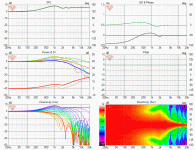
Kind of shocking how much there is change, not that much directly on axis other than diffraction related ripple changing, off-axis changes more, DI changes.
Purifi article lines up some distortion sources in loudspeaker drivers and they write example case where excursion changes effective Sd of driver. They list example that 5" driver with 8mm wide surround the Sd varies from nominal 80cm2 to 55cm2 to 105cm2 on extreme excursion.
https://purifi-audio.com/2021/10/14/some-speaker-problems-that-needed-solving/
Here is this plotted in graphs, a GIF animation cycling through ideal 5" driver Sd 55-80-105cm2 on ideal 20x35cm baffle.

Kind of shocking how much there is change, not that much directly on axis other than diffraction related ripple changing, off-axis changes more, DI changes.
- Home
- Loudspeakers
- Multi-Way
- Who makes the lowest distortion speaker drivers

